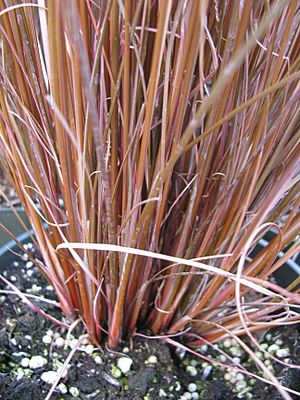Carex buchananii facts for kids
Quick facts for kids Carex buchananii |
|
|---|---|
 |
|
| Conservation status | |
|
Invalid status (NZ TCS)
|
|
| Scientific classification | |
| Genus: |
Carex
|
| Species: |
buchananii
|
 |
|
| Occurrence data from AVH | |
| Synonyms | |
|
Carex tenax Berggr. |
|
Carex buchananii, also known as Buchanan's sedge or cutty grass, is a special type of sedge. Sedges are grass-like plants that belong to the Cyperaceae family. This plant is only found in New Zealand, growing on both the North and South Islands.
Some plant experts, like those at Plants of the World Online, say it has no other names. However, the New Zealand Plant Conservation Network lists two older names for it.
What it Looks Like
Buchanan's sedge is a reddish-brown plant. It grows in thick, dense clumps, almost like a tuft of hair.
This sedge usually flowers from October to December. Its fruits appear from November to June. The tiny seeds inside these fruits are spread in two ways. Sometimes, animals eat the seeds and help spread them. Other times, the wind carries the seeds to new places.
Where it Grows
This sedge is not very common in the North Island of New Zealand. You can mostly find it south of the Manawatu region. In the South Island, it grows in more places. However, it has not been found in Westland or Fiordland.
You can find Buchanan's sedge in many different environments. It grows from the coast all the way up to the mountains. It can be found at altitudes of up to 1000 meters (about 3,300 feet). It likes to grow on beaches and along the edges of lakes and streams.
Is it in Danger?
Experts in New Zealand check on the health of plants using a system called the New Zealand Threat Classification System (NZTCS). In 2013, Buchanan's sedge was considered "Not Threatened," meaning it was doing well.
But by 2017, its status changed. It was then listed as "At Risk - Declining." This means that the number of these plants is starting to go down, and they might need some help to survive.
In the United Kingdom, this sedge is not native. It has started to grow there naturally, but it is considered an "invasive species." This means it can sometimes spread too much and harm local plants.
How it Got its Name
The first person to officially describe this plant was Sven Berggren. He did this in 1880. He gave it the specific name Buchanani (which is now spelled buchananii). He chose this name to honor a famous New Zealand botanist named John Buchanan (1819-1898).

